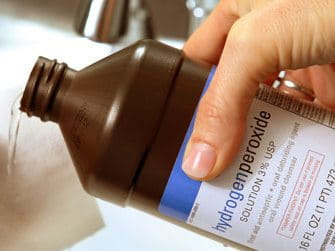Is Hydrogen Peroxide Safe?

The Bottom Line
Hydrogen peroxide is a highly reactive chemical available in several concentrations. Exposures to small amounts of household (3%) hydrogen peroxide usually only cause mild irritation. Higher concentrations can cause burns. Rarely, life-threatening effects can occur when oxygen bubbles from hydrogen peroxide travel to the circulatory system and block blood flow to tissue.

What is hydrogen peroxide?
Hydrogen peroxide is a highly reactive chemical usually diluted in water. Solutions of hydrogen peroxide in water appear very similar to water—they’re tasteless, odorless, and colorless. Unlike water (H2O), hydrogen peroxide (H2O2) has two oxygen atoms instead of one. Hydrogen peroxide is not as stable as water and can quickly break down into water and oxygen.
- Household hydrogen peroxide is sold in opaque bottles in drugstores and supermarkets. It contains 3% hydrogen peroxide.
- Some contact lens disinfecting solutions—the bottles with red caps—also contain 3% hydrogen peroxide.
- Hair bleach is 6–10% hydrogen peroxide.
- "Food-grade" hydrogen peroxide is 35%. Despite its name, "food-grade" hydrogen peroxide is not food and can cause serious internal burns if swallowed.
- Higher concentrations of hydrogen peroxide (up to 90%) are used in industry for things like bleaching paper.
What is hydrogen peroxide used for?
Hydrogen peroxide is widely used as a cleaner and disinfectant on surfaces like counters and cutting boards. It can be used to eliminate odors in dishwashers, sinks, garbage cans, toilets, and even cat boxes. It can also be used to remove some stains from fabrics.
Hydrogen peroxide was once used to disinfect skin wounds. This is no longer recommended. Research has shown that hydrogen peroxide can irritate or damage the cells needed for healing.
Household strength (3%) hydrogen peroxide is sometimes recommended to make dogs and cats vomit if they swallow poison. Do not induce vomiting in a pet unless advised to do so by your vet, by an expert at a human poison control center (1-800-222-1222), or by Animal Poison Control (a fee may apply to animal poison control consults). Some substances can be more dangerous to bring up than to leave in the stomach. WARNING: Do not use hydrogen peroxide to induce vomiting in children (or people of any age!).
“Food-grade” hydrogen peroxide, which is typically 35%, is sometimes promoted as an alternative therapy for a variety of conditions, such as allergies, arthritis, HIV, diabetes, emphysema, lupus, shingles, warts, and irregular heart rhythms. These uses are not based on scientific evidence. Users are instructed to put a few drops of the concentrated hydrogen peroxide into a glass of water. Users often store the hydrogen peroxide in the refrigerator, where it can be easily mistaken for something safe to drink. Children and adults who swallowed concentrated hydrogen peroxide have suffered severe injuries, and some have died.
Does hydrogen peroxide expire?
Household hydrogen peroxide is sold in opaque bottles to protect the unstable product from light. In a sealed opaque bottle, it should be good for about 3 years. Once the bottle is opened, hydrogen peroxide starts to break down and will only last for 1–6 months. To check if the hydrogen peroxide is still active, pour a small amount into a kitchen sink. If it fizzes or bubbles, it is still good.
Is hydrogen peroxide safe? Can you drink hydrogen peroxide?
In the stomach, hydrogen peroxide breaks apart into oxygen and water, causing bubbles to form. If there are enough of these bubbles, they can stretch the stomach. Swallowing a small amount (a taste or a sip) of household hydrogen peroxide might cause belching, an upset stomach, an episode of vomiting, or throat irritation, but it is not expected to cause any serious symptoms. It is different if someone drinks a large amount of household peroxide or if it is a high-concentration product. This can be much more serious and result in severe stomach irritation and even burns that require a trip to an emergency room and possible hospital admission.
A rare but serious complication that might occur with the ingestion or wound irrigation of hydrogen peroxide is a gas embolism. A gas embolism occurs when bubbles of air or other gas, like oxygen, released by hydrogen peroxide, enter the circulatory system. They can then cause blockages in blood vessels. Most cases of gas embolism caused by hydrogen peroxide have occurred after large ingestions or ingestions of products with high concentrations. Some symptoms of gas embolism include difficulty breathing, chest pain, and confusion. A gas embolism can be life-threatening and immediate medical attention is required.
What to do if you drink hydrogen peroxide or get it in your eyes or on your skin.
Swallowing a small amount of household hydrogen peroxide can be managed by taking a few sips of water to clear the esophagus. Eye exposure to 3% solutions can cause immediate stinging, irritation, tearing, and blurred vision, but severe injury is unlikely. Immediately rinse the eye with plenty of running water for 15–20 minutes. Hydrogen peroxide splashed onto the skin could cause the skin to blanch, or whiten, for a short time. The area might feel tingly for a while. Again, rinse with plenty of running water. Eye and skin burns are possible if a high concentration of hydrogen peroxide is involved.
Does hydrogen peroxide whiten teeth?
Hydrogen peroxide and its relative, carbamide peroxide, are found in tooth-bleaching products for home use and in dental offices. Because hydrogen peroxide can irritate body tissue, home users must follow directions closely to avoid problems. These products limit the contact of hydrogen peroxide to the tooth surfaces only. Tooth sensitivity can occur during treatment, along with gum irritation. Anyone thinking about using a home tooth-bleaching product should first consult with a dental professional. Do not use liquid hydrogen peroxide as a substitute for a tooth-bleaching product.
Can you put hydrogen peroxide in your ears?
Hydrogen peroxide is one of several liquids that can be used to loosen ear wax (cerumen). Use a dropper to put a small amount of hydrogen peroxide into the ear canal, wait a few minutes, and then flush the canal with warm water. Do not use a cotton swab in the ear canal. Swabs can push the ear wax farther into the ear canal and can accidentally puncture the eardrum. Stubborn ear wax should only be removed by a qualified healthcare professional.
If you believe someone has swallowed hydrogen peroxide or splashed it into their eye or onto their skin, use the webPOISONCONTROL online tool to get immediate help, or call Poison Control at 1-800-222-1222. Both options are expert, free and confidential.
Rose Ann Gould Soloway, RN, BSN, MSEd, DABAT emerita
Clinical Toxicologist
Revised William G. Troutman, PharmD
Professor of Pharmacy Emeritus
Poison Control Media Information
Did you find this page helpful? If so, we need your support. Poison Control is in constant competition with misinformation online. Links to www.poison.org or our webPOISONCONTROL triage tool from other websites and blogs help internet searchers quickly find accurate information and Poison Control’s contact information in an emergency. If you use the content from this page, please provide attribution via a link back to this page, www.poison.org, or https://triage.webpoisoncontrol.org/#!/exclusions. By doing so, you could save a life. Thank you!
Poisoned?
Call 1-800-222-1222 or
Prevention Tips
- Store all hydrogen peroxide products away from the sight and reach of children.
- For household use, only buy hydrogen peroxide 3% solution.
- Keep hydrogen peroxide in its original opaque bottle.
This Really Happened
Case 1. An 82-year-old woman was given about 2 tablespoonfuls of 32% hydrogen peroxide by her husband, who said he was a homeopath. She vomited at home and had trouble breathing. In the hospital, she had bleeding from her stomach or intestines. She was treated in the ICU for continued breathing problems and abnormal brain studies. She died after 15 days in the hospital (from Bronstein et al., 2011).
Case 2. A 2-year-old girl drank some 3% hydrogen peroxide that her mother had poured into a cup with the intent of using it to treat a cut. Poison Control advised the mother to give the girl some water to drink and to watch for gastrointestinal upset. During a follow-up call from Poison Control a few hours later, the child was fine.
For More Information
Hydrogen peroxide. US Agency for Toxic Substances and Disease Registry. April 2002. Accessed March 14, 2024.
Stanborough RJ. 22 healthy uses for hydrogen peroxide (and a few you should avoid). Healthline. Updated March 9, 2023. Accessed March 14, 2024.
References
Watt BE, Proudfoot AT, Vale JA. Hydrogen peroxide poisoning. Toxicol Rev. 2004;23(1):51-57.
Poisoned?
Call 1-800-222-1222 or
Prevention Tips
- Store all hydrogen peroxide products away from the sight and reach of children.
- For household use, only buy hydrogen peroxide 3% solution.
- Keep hydrogen peroxide in its original opaque bottle.
This Really Happened
Case 1. An 82-year-old woman was given about 2 tablespoonfuls of 32% hydrogen peroxide by her husband, who said he was a homeopath. She vomited at home and had trouble breathing. In the hospital, she had bleeding from her stomach or intestines. She was treated in the ICU for continued breathing problems and abnormal brain studies. She died after 15 days in the hospital (from Bronstein et al., 2011).
Case 2. A 2-year-old girl drank some 3% hydrogen peroxide that her mother had poured into a cup with the intent of using it to treat a cut. Poison Control advised the mother to give the girl some water to drink and to watch for gastrointestinal upset. During a follow-up call from Poison Control a few hours later, the child was fine.
